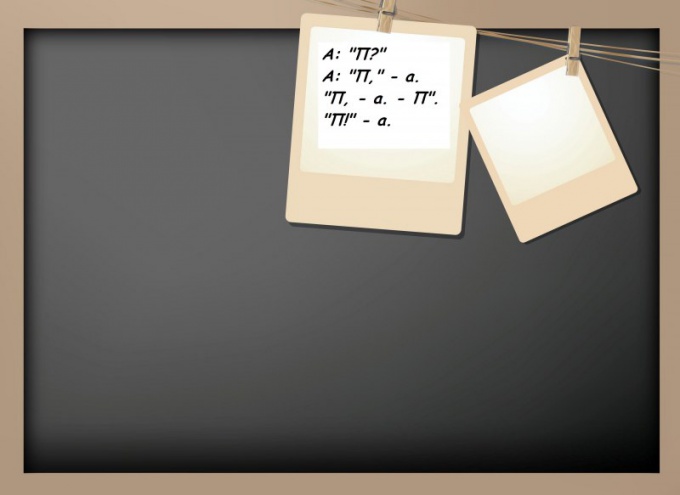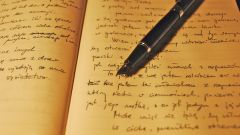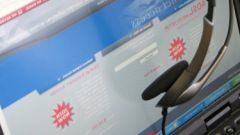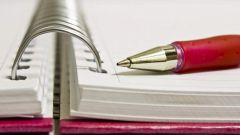Instruction
1
Read the text for which you want to chart. Find the direct speech. For clarity, it can be identified, for example, to underline in red pencil. Determine where the start and end words of the author. Their emphasize with a pencil blue. Please note, if continues after the direct speech author's words. It may consist of one or two sentences, linked by intonation.
2
Mark, what is emotional is direct speech. The sentence may be exclamatory, declarative, interrogative. In the end it is the appropriate punctuation, it is important to reflect in the scheme.
3
Use the legend to chart. The words of the author, as a rule, represent a capital or a lowercase "a", saying the character is a uppercase or a lowercase letter "p". It the character is enclosed in quotes. From the words of the author it separates the dash. However, the dashes are placed before direct speech, starting a proposal.
4
Check you compiled the schema. She must meet one of the following samples. If your option differs from the standard, perhaps you made a mistake when determining the direct speech and the words of the author, or missed the necessary punctuation.
5
Scheme No. 1: direct speech author's words. Saying a character is written with capital letters and enclosed in quotes. At the end of it a comma, exclamation or question mark in accordance with the intonation of a sentence. The author's words are written with lowercase letters and separated from the direct speech dash. Examples:
1. "The house," said the father.
2. "The guests arrived!", - happy father.
3. "The guests arrived?" - surprised father.
For these proposals the scheme will be as follows:
1. P.
2. "P!" .
3. "P?" .
1. "The house," said the father.
2. "The guests arrived!", - happy father.
3. "The guests arrived?" - surprised father.
For these proposals the scheme will be as follows:
1. P.
2. "P!" .
3. "P?" .
6
Scheme No. 2: direct speech after the author. The words of the author are capitalized. After them there is a colon. Next, in quotes with a capital letter should be direct speech. Examples:
1. The father said, "the house".
2. The father was delighted: "the Guests arrived!"
3. The father was surprised: "the Guests arrived?"
Schemes such sentences have the form:
1. A: "P".
2. AND: "P!"
3. AND: "P?"
1. The father said, "the house".
2. The father was delighted: "the Guests arrived!"
3. The father was surprised: "the Guests arrived?"
Schemes such sentences have the form:
1. A: "P".
2. AND: "P!"
3. AND: "P?"
7
Scheme No. 3: the words of the author inside of direct speech. In this case, the quotation is the entire sentence. After the first part of direct speech a comma. The copyright part is written with a lowercase letter. Before the words of the author and put a dash after them. The second part of direct speech may be a continuation of the first, then it is spelled with a lowercase letter. If it is an independent sentence, after the words the author put a dot and then the text starts with a capital letter. Examples:
1. "The guests arrived, the father said, - go to meet them".
2. "The guests arrived, her father said. – Go to meet them".
The right diagram sentences in this case:
1. "P, - a, - p".
2. "P - and. – P".
1. "The guests arrived, the father said, - go to meet them".
2. "The guests arrived, her father said. – Go to meet them".
The right diagram sentences in this case:
1. "P, - a, - p".
2. "P - and. – P".
8
Scheme No. 4: direct speech inside the words of the author. The first part of the words of the author is written with a capital letter, the second with a lowercase. Direct speech is quoted. Front of her put a colon after it – the intonation necessary punctuation and dashes. Examples:
1. The father said, "the Guests arrived," and went to meet them.
2. The father was delighted: "the Guests arrived!" and went to meet them.
3. The father was surprised: "the Guests arrived?" and went to meet them.
For such proposals fit with the following schema:
1. A: P - a.
2. AND: "P!" .
3. AND: "P?" .
1. The father said, "the Guests arrived," and went to meet them.
2. The father was delighted: "the Guests arrived!" and went to meet them.
3. The father was surprised: "the Guests arrived?" and went to meet them.
For such proposals fit with the following schema:
1. A: P - a.
2. AND: "P!" .
3. AND: "P?" .








